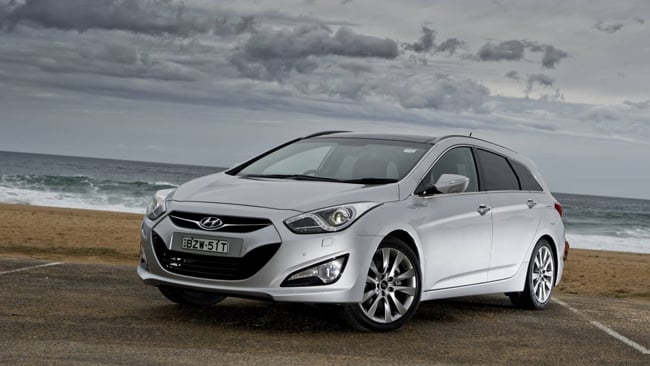It’s about time Hyundai started building memorable cars. About time its worth as a global brand was measured in terms other than steeping sales and profitability. And maybe the i40 Tourer suggests Hyundai also realises the clock is ticking, because this mid-size wagon is just about the most interesting mainstream car the big Korean has launched in Australia.
The photography might not leave that impression, but what appears heavy and even bloated in two-dimensions assumes more grace and poise in three. It is the first Hyundai that makes you stop and look… for the right reasons. And it’s intentional. The eagles eyes, creased sides, reverse D-pillar and long rear overhang are an interpretation of the ‘Fluidic Sculpture’ design language emanating from its European design office in Germany.
If new-found style doesn’t impress, then there’s always i40’s impressive set of numbers to attract attention. Try out nine airbags, a five-star ANCAP rating and a five-year/unlimited km warranty. Pricing starts at $32,490 for the Active petrol manual, rising as high as $46,490 for the Premium diesel auto. Supply is constrained out of the Ulsan plant in Korea, so Hyundai is expecting about 150 sales per month.
Inside, the i40 looks and feels quality and offers masses of practical people and luggage space courtesy of its front-wheel drive layout and 4.77m length.
The engineering development also owes much to Hyundai’s German outpost, reflecting the i40’s primary intended function as a booster for the company’s lagging European sales share.
Building on the architectural core that also underpins the mid-size i45 sedan, the i40 has Mac struts and multi-links, electric-assist power steering and the choice of naturally-aspirated 2.0-litre petrol and 1.7-litre turbo-diesel four-cylinder engines.
The base model Active gets a six-speed manual, primarily to promote the low $30K entry price for the petrol and a stellar 4.7L/100km fuel consumption average for the diesel. But a six-speed auto is the only choice for mid- and upper-spec Elite and Premium buyers.
The diesel-auto is clearly the better powertrain. An unappealing 12.0 sec 0-100km/h claim belies the way it combines thrift with smooth punch in a way the shallower ‘Nu’ petrol engine cannot match. Only its $2000 price advantage sways the argument.
Australia has an engineering involvement in the i40, because it has gone through the same local-iced suspension and steering tuning that began with the latest (and impressive) Elanora. Ten thousand kilometres of comparative testing resulted in a softer damper, firmer spring, thicker front sway bar and a power steering remap designed to reduce stickiness just off centre.
The result is a ride that is comfortable on the 16-inch wheeled Active, degrading to stilted on the Premium’s 18s. Still acceptable however, and body control is disciplined throughout.
Steering mods are less successful. Accurate? Yes. Communicative? No. It is the obvious deficiency that ensures the likes of the Mazda6 and Ford Mondeo are a dynamic class above. Only one class now mind you, which is almost a victory for Hyundai.
But almost isn’t good enough. While Hyundai’s quest for respect takes an important step forward here, the i40 isn’t a triumph. Wheels marks tough when it comes to dynamics, and that unarguably is a cornerstone of building truly memorable cars.





